Introduction
The United Nations (UN) adopted in 2015 the 2030 Agenda for Sustainable Development which has as objective the rerouting of humanity on a sustainable path by defining 17 goals containing 169 targets which are built on economic, social, and environmental pillars that describe the main challenges for mankind (Momete & Momete, 2021). Their aim is to achieve a prosperous and just life, in peace and security for all in present and in future (United Nations, 2015). Within the sustainable development goals (SDGs) encompassed by 2030 Agenda, education is formulated as a stand-alone goal (SDG4 – quality education) but also serves as a means to achieve other SDGs (SDG3-health and wellbeing, SDG5 – gender equality, SDG8 – decent work, SDG11- sustainable cities and communities, SDG12 – responsible production and consumption and SDG13 – climate change mitigation). SDG4, through its 10 targets, aims to “ensure inclusive and equitable quality education and promote lifelong learning opportunities for all” (SDG 4 High-Level Steering Committee, 2021). The European Commission has confirmed the integration of the 17 SDGs comprised in the 2030 Agenda into EU public policies, with a view to ensure a dignified life for all, respecting the limits of the planet, pledging for prosperity and economic efficiency, peace, social inclusion and environmental responsibility (European Commission, 2016).
Education represents a key determinant of wellbeing and is beneficial for the economic development of a country/region (Rowlands & al, 2017), and when sustainability is also integrated, the economic development may be sustainable. The mechanisms of economic growth through education are complex, ranging from offering a qualified work force, to innovation and transmission of information (Hanushek & Woessmann, 2020) (Rieckmann, 2017), but sustainability must be integrated to offer a robust path to sustainable development. The purpose of education for sustainable development is to integrate the multifaceted dimensions of sustainable development into all educational aspects (Uitto & Saloranta, 2017) (UNESCO, 2017). The goal of teaching for sustainable development may follow a skills-oriented paradigm (Paths, 2000) or a competence-based one (de Haan, 2010). Topics in the context of a sustainable
future include climate change, biodiversity, the rational use of natural resources (e.g., soil, water, fossil energy resources), health, (Buckler & Creech, 2014) multiculturalism, cultural heritage and global well-being (Cooper & Chen, 2014). An education for sustainable development means that all aspects of the educational process are transformed, from planning and policy development at national level, to funding, changes in curricula (contents), teaching, evaluation and learning. Creating a more sustainable future requires a permanent interaction between school, students and communities (Bezeljak et al, 2000).
Sustainable development looks desirable and easily comprehensible, but the actual major results are difficult to grasp (Momete, 2017) and most of them appear to be disconnected from a prosperous and just life, aimed by Agenda 2030. SDG 4 is focused on quality in education, but it does not mean that it is a perfectly expressed goal, as there are researchers who have criticized it and labelled it as weak and lacking in concreteness (Kopnina, 2020). Moreover, the actual implementation of Agenda 30 which sets the objectives to 2030, is insufficient worldwide and produced no substantial change. The COVID-19 added an additional strain to the already strained global systems, educational system being one system really hit by the pandemic. The UN speaks about a “generational catastrophe” induced by the COVID -19 and about 20 years of constant gains which were “wiped out by the COVID-19” (United Nations, 2021).
Education needs a major reform worldwide, but the real transformation is very challenging, and the first step is to identify the determinants of an authentic literacy for sustainability. The literacy for sustainability can change the world and refers to the development of the skills, attitudes, competences, dispositions, and values necessary “to survive and thrive in the conditions of decline of the world in ways that slow this decline as much as possible” (Stibbe, 2009). Therefore, this paper has as main objective the identification of the relevant key performance indicators (KPI’s) to be employed with the aim to track the performance and identify the essential difficulties for the implementation of education for sustainable development (ESD) within the EU27 member states and highlights Romania’s situation. The conceptual framework is then applied to identify the worst performers for each KPI.
Methodology
The present paper aims to answer the following research questions:
RQ1: Which are the main KPIs suitable to track the performance in ESD?
RQ2: Which are the essential difficulties for the implementation of an ESD within the EU27 member states?
RQ3: Which are the worst performers for each considered KPI?
RQ4: Which is the particular situation of Romania?
A conceptual framework is considered to access the implementation of ESD within the EU27 member states and is designed on six KPIs. The conceptual framework (FEN) is based on 3 axes (see figure 1):
- Axis 1 (F): Formal education, with the indicators F1 and F2;
- Axis 2 (E): Essential knowledge, with the indicators E1 and E2.
- Axis 3 (N): Non-formal education, with the indicators N1 and N2;
The data for F1, F2, E1, E2 and N1, N2 are retrieved from international databases (Eurostat, 2021a-d) (OECD, 2021) applicable for the last available year.

Figure 1. FEN conceptual framework.
Analysis of the key performance indicators for ESD
Education for sustainable development is an approach that empowers learners to make decisions for responsible consumption of resources, respect for the integrity of the environment, supporting a just and economically viable society for present and future generations. Education for sustainable development is a holistic and transformative education that targets new learning content, new pedagogical approaches, and new learning environments. An education for sustainable development is aimed to develop competences so that learners can contribute to the promotion of societal change (Rieckmann, 2012). However, in order to achieve a sustainable education, the starting point must be the identification of the actual situation for formal education, essential knowledge of students and non-formal education.
Formal Education
F1: This indicator refers to the share of the population aged 18- 24 with at most lower secondary education (see figure 2). The values range from 2.20% in Croatia to 16.20% in Malta, with a mean EU27 value of 9.90%. The countries placed above 10% are in a difficult situation, therefore, Cyprus, Hungary, Bulgaria, Italy, Romania, Spain and Malta have to tackle carefully the problem of early leavers form education.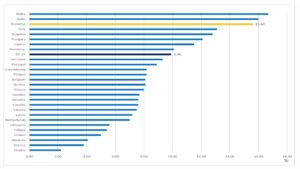
Figure 2. Population aged 18-24 with at most lower secondary education (%).
Source: processed from (Eurostat, 2021a).
F2: The share of the population aged 25-34 who have completed tertiary studies is presented in figure 3. The values range from 60.60 % in Luxembourg to 24.90% in Romania, with a mean EU27 value of 40.50%. The countries placed below 40% are in a difficult situation, therefore, Slovakia, Croatia, Germany, Bulgaria, Czechia, Hungary, Italy and Romania have to carefully tackle this problem.
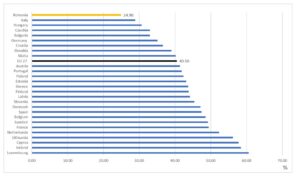
Figure 3. Population aged 25-34 with completed tertiary studies (%).
Source: processed from (Eurostat, 2021b).
Essential knowledge
E1: The share of 15-year-old students failing to reach basic skills level on the PISA scale for mathematics (level 2) is presented in figure 4. The values are ranging from 10.20% in Estonia to 46.60% for Romania, with a mean EU27 value of 22.90%. The countries placed above 30% are in a difficult situation, therefore, Malta, Croatia, Greece, Cyprus, Bulgaria and Romania have to carefully tackle the actual basic skills in mathematics.
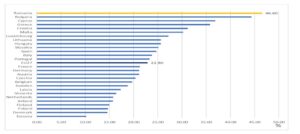
Figure 4. 15-year-old students failing to reach level 2 on the PISA scale for mathematics (%).
Source: processed from (OECD, 2021).
E2: The share of 15-year-old students failing to reach basic skills level on the PISA scale for reading is presented in figure 5 (level 2). The values are ranging from 11.10% in Estonia to 47.10% for Bulgaria, with a mean EU27 value of 22.50%. The countries placed above 30% are in a difficult situation, therefore, Greece, Slovakia, Malta, Romania, Cyprus and Bulgaria have to carefully tackle the actual basic skills in reading.
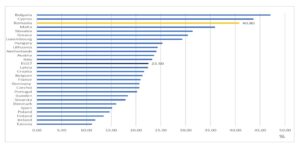
Figure 5. 15-year-old students failing to reach level 2 on the PISA scale for reading (%).
Source: processed from (OECD, 2021).
Non-Formal Education
N1: The share of people aged 25-64 who stated that they received non-formal education and training is presented in figure 6. The values range from 28.60% in Sweden to 1.00 % in Romania, with a mean EU27 value of 9.20%. The countries placed below 10% are in a difficult situation, therefore, Slovenia, Germany, Belgium, Italy, Lithuania, Latvia, Czechia, Hungary, Cyprus, Greece, Poland, Croatia, Slovakia, Bulgaria, and Romania must carefully tackle this challenge.
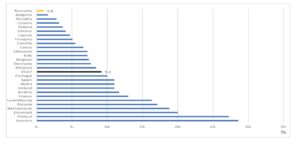
Figure 6. Population aged 25-64 which participated in non-formal education (%).
Source: processed from (Eurostat, 2021c).
N2: The share of people aged 16-74 who have at least basic digital skills is presented in figure 7. The values range from 79.00% in Netherlands to 29.00 % in Bulgaria, with a mean EU27 value of 56.00%. The countries with values below 50.00% are in a difficult situation, therefore, Hungary, Cyprus, Poland, Latvia, Italy, Romania, and Bulgaria have to carefully tackle this problem.
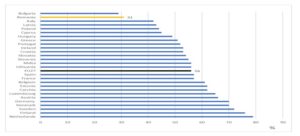
Figure 7. Population aged 16-74 with at least basic digital skills (%).
Source: processed from (Eurostat, 2021d).
The overall performace of EU27 member states is represented in figure 8, showing that the worst performce is obtained for N1 indicator.
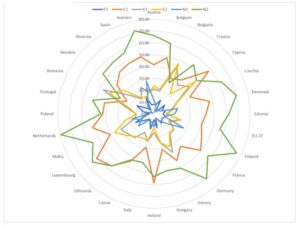
Figure 8. Overall performance in education for sustainable development in EU27.
Source: (Eurostat, 2021a), (Eurostat, 2021b), (Eurostat, 2021c), (Eurostat, 2021d), (OECD, 2021).
The evolution of the situation in Romania between 2006 and 2020 (2018 is the last year available for PISA tests) is represented in the figure 9, which contains all the series analyzed on a positive criterion. An improvement in the situation is observed on most of the series, which, however, is not enough and Romania is still far from the objectives on SDG 4 at EU level (Momete, 2022).

Figure 9. The evolution of the situation in Romania for quality education.
Source: (Eurostat, 2021a), (Eurostat, 2021b), (Eurostat, 2021c), (Eurostat, 2021d), (OECD, 2021).
Results and Discussion
Education is the foundation of human society and represents an essential key to achieve sustainable development at global level. Sustainable development is that type of “development that meets the needs of the present without compromising the ability of future generations to meet their own needs” (Brundtland, 1987). In line with this view, this paper introduces an original framework, based on 3 axes, each with two KPIs. The formal education is considered by this research important for both ends of education chain, considered by F1 and F2. For the ones having the lowest education (at most secondary education) and for those with tertiary education. The non-formal education includes both non-formal instructions, and digital skills, revealed by N1 and N2. The essential knowledge refers to the basic skills in mathematics and reading, being revealed by E1 and E2. The thresholds considered for each KPI are based on the authors’ opinions.
The quality of teaching is essential so that students can find inspiration in the classroom and reach their full potential. Society has been transformed, innovation and digital technologies have evolved, but new possibilities to improve teaching and learning have not been fully explored by schools and teachers, Romania, for example, having a very high inertia in their use. However, the teacher or the school cannot bring a change at a systemic level, which is why answers are needed from the authorities responsible for education (Eurydice, 2019). Therefore, in order to focus on the proper responses, the problems must be acknowledged and dealt with (see table 1).
Table 1. Overall results and identified problems.
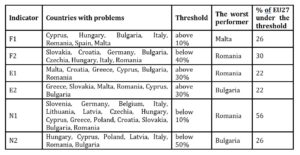
The countries performed best for E1 and E2, only 22% of EU27 being under the threshold, while the worst performance was registered for N1, with 56% of countries below the threshold. Romania and Bulgaria are the sole countries present within all the considered series, showing that essential effort is needed on all levers of education. Romania is an underachiever for all KPIs, and scores last for three indicators, being the country with the worst overall performance from EU27. Our findings are in line with other studies referring to Romania which concluded that 40 indicators of sustainable development are under-optimal, education being one of them (Draghici, 2019) (Firoiu et al, 2019). Cyprus has major problems for five indicators; Italy and Hungary have problems for four indicators; Slovakia, Malta, Croatia and Greece for three indicators; Poland, Czechia, Germany and Latvia have to solve the situation for two indicators and Spain for one indicator.
Unfortunately, in Romania children do not reach their potential if we analyse the results from the PISA 2018 test (the last one available at the time of the research). The results show a slight improvement over the 2006 PISA test in Romania. Thus, almost 53% of 15-year-olds were identified without large gaps in mathematics in 2018, compared to 47% in 2006 (OECD, 2021). Moreover, almost 59% of 15-year-olds were identified as literati in 2018, while in 2006 the percentage reached 46.5% (OECD, 2021). It is obvious that there is progress, however, the figures place Romania in difficult position in the EU (in mathematics on the last place, and in reading – understanding a text – on the antepenultimate place), and far from the target proposed for 2020 at the EU level of 85% (European Commission, 2022). Many children continue to leave the education system very early (almost 16% left the system too early in 2020), although a slight improvement has occurred since 2006 when 18% left the system too early, but far from the stated 2020 target of 11.3% (Eurostat, 2021a). Thus, they are not well prepared for life and leave the system before they have developed their basic skills for a decent life. At the level of people with higher education, the situation in Romania is dramatic. In 2020, nearly 25% of people aged 25-34 had completed tertiary education. The percentage places Romania on the last place in the EU, the EU average being over 40%. The situation has improved compared to 2006, when only almost 15% completed tertiary studies, but it is far from the EU average (Eurostat, 2021b) and the 2030 target of 45% (European Commission, 2022). The situation of adult participation in non-formal education is even more dramatic, Romania being on the last place, at a great distance from the other EU member states. If in 2006 Romania had a participation percentage of 1.5%, in 2020, the situation worsened and reached only 1%, very far from the EU average of 9.2% (Eurostat, 2021c). With regard to people who have at least basic digital skills, the situation is equally worrying. Thus, in 2020, only 31% of people in Romania in the age range of 16-74 possessed basic digital skills, far from the EU average of 56%. The situation has improved a little compared to 2015 when only 26% of the Romanian population aged 16-74 had basic digital skills, but Romania is still on the last place in the EU (Eurostat, 2021d). It is worth mentioning that PISA testing has always been carried out in the pen & paper system, in 2018 being the only country in the EU that did not opt for the digital testing system. In addition, since 2020, the pandemic situation has affected access to education and its quality, at all age levels.
Conclusions
Our belief is that education can and must contribute to a new vision of global sustainable development. Education is the catalyst for the transformation of individuals and society as a whole, being responsible for the values and competences that will lead to sustainable and inclusive growth in a peaceful and fair climate. Thus, through a sustainability-oriented education, individuals will become agents of transforming society into a sustainable one through knowledge, values, skills and attitudes that will contribute to building a sustainable future.
This research has identified an original conceptual model which shows that several countries of EU27 are still underachievers in terms of sustainable education, the worst performers being Romania and Bulgaria. This challenge should be turned into an opportunity for education and learning about what are the real challenges and how to overcome them. Therefore, there is a need for new training schemes and training programs that can be considered for underachievers in order to develop skills, modify attitudes and form characters.
The main limitations of this research are the available data, as there are many data gaps and data lags in the official statistics for education. Nevertheless, the considered KPIs appropriately cover the intended objective and may be further used for an in-depth tracking of performance for education for sustainable education.
This research is part of a larger study aiming to identify a hierarchy of performance in education for sustainable development across European Union countries.
Acknowledgment
This paper is financed by the University POLITEHNICA of Bucharest, “Engineer in Europe” project, identified by number 140GP/19.04.2021, through the Romanian Ministry of Education fund for financing special situations.
References
- Bezeljak, P., Scheuch, M., and Torkar, G. (2020), Understanding of Sustainability and Education for Sustainable Development among Pre-Service Biology Teachers Sustainability 12, 6892. https://doi.org/10.3390/su12176892.
- Brundtland, G. H. (1987), Our Common Future, From One Earth to One World, World Commission on Environment and Development, United Nations. [Online], [Retrieved: September 18, 2022]. Available: https://sustainabledevelopment.un.org/content/documents/5987our-common-future.pdf.
- Buckler, C., and Creech, H. (2014), Shaping the future we want: UN Decade of Education for Sustainable Development, UNESCO, [Online], [Retrieved: September 24, 2022]. Available: https://sustainabledevelopment.un.org/index.php?page=view&type=400&nr=1682&menu=35.
- Cooper, L. C., and Chen, P. Y. (2014), Wellbeing: A Complete Reference Guide, Work and Wellbeing (Vol. III), John Wiley & Sons, Oxford.
- de Haan, G. (2010), The development of ESD-related competencies in supportive institutional frameworks, International Review of Education, 56, 315-328. https://doi.org/10.1007/s11159-010-9157-9.
- Draghici, A. (2019), Education for sustainable development. 9th International Conference on Manufacturing Science and Education – MSE 2019 “Trends in New Industrial Revolution”, Volume 290, 13004, MATEC Web of Conferences. https://doi.org/10.1051/matecconf/201929013004.
- European Commission (2016), Communication from the Commission to the European Parliament, the Council, the European Economic and Social Committee and the Committee of the Regions “Next steps for a sustainable European future European action for sustainability”, COM(2016)793.
- European Commission. (2022). Sustainable development in the European Union – Monitoring report on progress towards the SDGs in an EU context, Luxembourg: Publications Office of the European Union.
- Eurostat on-line database, (2021a), online data code: EDAT_LFSE_03.
- Eurostat on-line database, (2021b), online data code: EDAT_LFSE_14.
- Eurostat on-line database, (2021c), online data code: ISOC_SK_DSKL_I.
- Eurostat on-line database, (2021d), online data code: TRNG_LFSE_01.
- Eurydice, (2019), The Organisation of School Time in Europe. Primary and General Secondary Education – 2019/20, (EACEA/Eurydice, Ed.), Publications Office of the European Union, Luxembourg.
- Firoiu, D., Ionescu, G., Bandoi, A., Florea, N. M., and Jianu, E. (2019), Achieving Sustainable Development Goals (SDG): Implementation of the 2030 Agenda in Romania. Sustainability, 11, 2156. https://doi.org/10.3390/su11072156.
- Hanushek E., and Woessmann L. (2020), A quantitative look at the economic impact of the European Union’s educational goals, Education Economics, 28:3, 225-244, doi: 10.1080/09645292.2020.1719980.
- Kopnina, H. (2020), Education for the future? Critical evaluation of education for sustainable development goals, The Journal of Environmental Education, 51:4, 280-291, doi: 10.1080/00958964.2019.1710444.
- Momete, D.C. (2017), Rational Development as a Sustainable Progress Welfare Vector: A Cross-Country Analysis, Sustainable Development, 25:3, 189-199, doi: 10.1002/sd.1645.
- Momete, M. M., & Momete, D. C. (2021). Study on the implementation of sustainable education in European Union. Proceeding of the 38th International Business Information Management Association (IBIMA), (pg. 2314-2320). Seville, Spain.
- Momete, M.M. (2022). Dissertation Thesis: Valences of integrating education for sustainable development into educational practice, University Politehnica of Bucharest, Romania.
- Organisation for Economic Co-operation and Development (OECD) (2021), OECD online database, online data code: EDUC_OUTC_PISA.
- Rieckmann, M. (2012), Future-oriented higher education: Which key competencies should be fostered through university teaching and learning? Futures, 44(2), 127-135.
- Rieckmann, M. (2017), Education for Sustainable Development Goals: Learning Objectives, UNESCO Publishing, Paris.
- Rowlands G., Shaw A., Jaswal S., Sian Smith, and Harpham T. (2017), Health literacy and the social determinants of health: a qualitative model from adult learners, Health Promotion International, 32:1, 130–138, https://doi.org/10.1093/heapro/dav093.
- SDG4 – High-Level Steering Committee (2021), Sustainable Development Goal 4 (SDG 4). [Online]. [Retrieved: October 11, 2021]. Available: https://sdg4education2030.org/the-goal
- Stibbe, A. (2009), The Handbook of Sustainability Literacy: Skills for a Changing World., Green Books Darligton.
- Uitto, A., and Saloranta, S. (2017), Subject Teachers as Educators for Sustainability: A Survey Study. Education Sciences, 7:1. doi:10.3390/educsci7010008.
- United Nations (2015), Transforming our world: the 2030 Agenda for Sustainable Development. Retrieved: 10 September 2021. [Online]. [Retrieved: October 12, 2022]. Available: https://www.un.org/ga/search/view_doc.asp?symbol=A/RES/70/1&Lang=E.
- United Nations Educational, Scientific and Cultural Organization (UNESCO) (2017). Education for Sustainable Development Goals, UNESCO, Paris
- United Nations (2021), Ensure inclusive and equitable quality education and promote lifelong learning opportunities for all, Department of Economic and Social Affairs. [Online]. [Retrieved: October 13, 2022]. Available: https://sdgs.un.org/goals/goal4.












